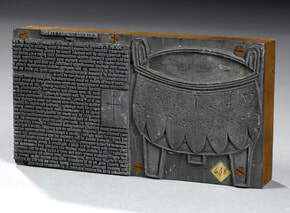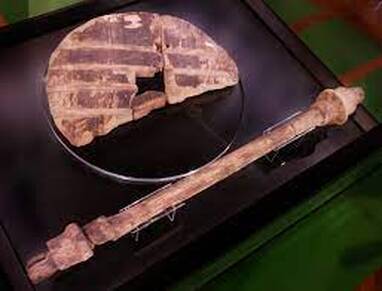David Tickner's Blog, page 22
May 20, 2022
+ - x ÷ =
 Can you imagine doing math before math symbols were created? Imagine if you had to write out, “Five multiplied by six is equal to thirty” or “Forty-eight divided by four is equal to twelve” every time you sat down to do your math homework.
Can you imagine doing math before math symbols were created? Imagine if you had to write out, “Five multiplied by six is equal to thirty” or “Forty-eight divided by four is equal to twelve” every time you sat down to do your math homework.Thank goodness someone invented some shortcuts. Now you can just write, 5 x 6 = 30, or 48 ÷ 4 = 12. Think of the savings in time and ink.
Where do these mathematical symbols come from?
+ Plus
The plus sign is a short version of Latin et (and); i.e., the ‘t’ in et becomes +. This symbol was first used in the mid-14th century by the French mathematician Nicolas d’Oresme (1323 – 1382).
In ancient Egyptian hieroglyphics, plus was indicated by a pair of feet walking in the direction in which a document was read; minus was indicated by a pair of feet walking backwards toward what had already been read.
— Minus
The minus sign was developed in 1494 by the Italian mathematician Luca Pacioli (1445 – 1517).
x Multiply
The multiplication sign ‘x’ was developed and popularized by the English mathematician William Oughtred (1574 – 1660). He also invented the slide rule. Some think a dot ● should have been used instead of ‘x’ because possible confusion with x = multiply, the x in x2 + y2 = z2, ‘x marks the spot’, ‘x as the unknown factor’, and so on. However, like any good meme, the ‘x’ sign for multiplication has won the day.
÷ Divide
The ÷ symbol for divide is called an obelus, the Greek word for a pointed stick. The first use of the sign is credited to the Swiss mathematician Johann Rahn (1622 – 1676) who first used it in 1659.
= Equal
The equal sign was invented by the English mathematician Robert Recorde (d. 1558).
What were the equivalent symbols used by the Islamic mathematicians of the early Middle East and South Asia long before the ‘+ - x ÷ =’ symbols were invented by the medieval European mathematicians? Sounds like another research project.
Reference: Online Etymological Dictionary, https://www.etymonline.com/
https://encyclopediaofmath.org/wiki/Mathematical_symbols
https://www.scienceabc.com/pure-sciences/start-using-math-symbols
https://www.huffpost.com/entry/where-and-when-did-the-sy_b_2860100
Published on May 20, 2022 18:05
May 15, 2022
Investigate, Learn
 Have you ever had to investigate something? In its origins, the word investigate means ‘to track something down’.
Have you ever had to investigate something? In its origins, the word investigate means ‘to track something down’.The word investigate comes from Latin vestigium (a footprint, a trace), a word of unknown origin. Combining Proto-Indo-European (PIE) en (in) + Latin vestigare (to track, to trace) creates investigare (to search into, to search after, to investigate).
The word investigate came to English around 1500 from Latin investigare. The word vestige (a mark, trace, sign) is from around 1600.
If you are a teacher or trainer, you may be interested to know that the word learn has its origins in the PIE root lois (furrow, track). The word learner, in its origins, means to follow or find the track. A learner follows in the footsteps of the teacher. Could we also say that a learner is someone who investigates?!
And, if you are a cobbler or a shoemaker, you may be interested to know that the PIE root lois is also the source of the Old English word laest (sole of the foot). A shoemaker’s last is a device used when making shoes. “Built to last” means that the shoes are custom-made, not that they will last forever!
Reference: Online Etymological Dictionary, https://www.etymonline.com/
Published on May 15, 2022 11:18
May 9, 2022
Theodolite
 Is the word theodolite related to words such as theology or theory?
Is the word theodolite related to words such as theology or theory?Strangely, it seems very odd that we know so little of the origins of the word naming such a sophisticated and important instrument. A theodolite is traditionally used by land surveyors. It is also used in building and infrastructure construction.
So, what is known or can be surmised about the origins of the word theodolite? What is known is that in the 1570s an English mathematician, Leonard Digges, developed and used such an instrument to measure horizontal and vertical angles. Some suggest that he called his instrument a theodelitus, from Greek words meaning ‘to behold or to look upon attentively’.
Others suggest that the theodelitus may be based on an older Arabic surveying instrument called an alidade (a ruler).
Other than this, not much is known for certain.
To answer the opening question, the word theodolite is not related to theology (i.e., from Greek theos = god). However, the word theodelitus may be related to the word theory. Both words are from Greek theoros = spectator. Theoros is also the origin of the word theatre—a place to which we go in order to see something. Similarly, theory: “Ahhh… now I see what you mean!”
Reference: Online Etymological Dictionary, https://www.etymonline.com/
Published on May 09, 2022 20:09
May 5, 2022
Magazine
 The word magazine has its origins in Arabic makhazin (storehouse) and 15th century French magasin (warehouse, depot, store). The word magazine came to English in the 1580s meaning a warehouse or a place for storing goods, especially military ammunition.
The word magazine has its origins in Arabic makhazin (storehouse) and 15th century French magasin (warehouse, depot, store). The word magazine came to English in the 1580s meaning a warehouse or a place for storing goods, especially military ammunition.How did magazine come to mean a weekly or monthly periodical? Perhaps if you were a manager of a warehouse or a ‘magazine’, you likely produced documents that regularly listed the contents or inventory of your storage facility; a magazine about the magazine, so to speak.
The first magazine, as printed periodicals are known today, was the Gentleman’s Magazine produced in 1731. It was a collection of miscellaneous writings, a storehouse of information.
When the repeating rifle was invented in the mid-19th century, the rifle’s cartridge chamber or magazine was where you stored cartridges when you weren’t using them. The use of magazine to mean the case in which a supply of cartridges is carried is from 1892.
Reference: Online Etymological Dictionary, https://www.etymonline.com/
Published on May 05, 2022 22:06
April 30, 2022
Intoxication
 The word intoxication, meaning the administration of a poison, came to English around 1400 from Latin intoxicare (to poison) and toxicum (poison). Greek toxikon referred to the poison put on the tips of arrows.
The word intoxication, meaning the administration of a poison, came to English around 1400 from Latin intoxicare (to poison) and toxicum (poison). Greek toxikon referred to the poison put on the tips of arrows.Intoxicate, meaning to make drunk, is from the 1570s. Intoxication, meaning the state of inebriation, is from the 1640s.
The term toxin, an organic poison produced by bacteria in an animal body, is from 1886. The medical term toxic waste is from 1888. Toxic waste referring to chemical or radioactive waste is from 1955.
Yum. Have another drink.
Reference: Online Etymological Dictionary, https://www.etymonline.com/
Published on April 30, 2022 18:00
April 22, 2022
Earth Day
 Earth
EarthThe word earth has its origins in the Proto-Indo-European (PIE) root er (earth, ground) and Proto-Germanic ertho, the source of Old English eorbe (ground, soil, dirt, country, district).
The word earth came to English before the 12th century from Old English and later from Middle English erthe.
JRR Tolkien’s term ‘Middle Earth’ is from Old English middangeard and Old Norse midgard (the inhabited world) from Old Norse mythology.
Earth Day
Earth Day is celebrated around the world each year on 22 April to demonstrate support for environmental protection. The first Earth Day was in 1970. The Earth Day flag (above) was also created in 1970.
Reference: Online Etymological Dictionary, https://www.etymonline.com/
https://www.earthday.org/
Published on April 22, 2022 07:48
April 17, 2022
Cliche
 Cliché, from French, is printer’s jargon for a ‘stereotype block’—a method of printing from a metal plate, called a stereotype, so that a print or design can be reproduced endlessly and identically or with only minor changes. The use of cliché in French to refer to a trite phrase or worn-out expression is from 1888. The word cliché came to English in the 1920s meaning any over-worked or over-used word or phrase.
Cliché, from French, is printer’s jargon for a ‘stereotype block’—a method of printing from a metal plate, called a stereotype, so that a print or design can be reproduced endlessly and identically or with only minor changes. The use of cliché in French to refer to a trite phrase or worn-out expression is from 1888. The word cliché came to English in the 1920s meaning any over-worked or over-used word or phrase.Clichés are the elephant in the room (1950s). All things being equal (1849), avoid them like the plague (1845). Better late than never (early 14th century).
It is going to be a steep learning curve (1885) but think outside the box (1975). Remember to be politically correct (1793). No pain, no gain (1734).
If nothing works, oh well, back to the drawing board (1941). Get over it (1687).
Each date indicates when the cliché first appeared in English.
Image: Stereotype, National Museum of Scotland
Reference: Online Etymological Dictionary, https://www.etymonline.com/
Fountain, N. (2012). Clichés: Avoid them like the plague! London: Michael O’Mara Books.
Published on April 17, 2022 11:24
April 12, 2022
Easel
 The word easel comes from Latin asinus (ass), defined by a dictionary as a “solid ungulate quadruped beast of burden of the horse kind, but smaller and with long ears and a short mane, native to southwest Asia.” The words ass and donkey are synonymous.
The word easel comes from Latin asinus (ass), defined by a dictionary as a “solid ungulate quadruped beast of burden of the horse kind, but smaller and with long ears and a short mane, native to southwest Asia.” The words ass and donkey are synonymous.Latin asinus is the source of Dutch esel (ass) and, later, Dutch ezel (easel); the comparison being of loading a donkey and propping up a painting or canvas on a wooden stand. The word easel came to English in the 1590s.
So, the next time you hear someone say, “I think I better get my ass in gear”, it likely means that they are getting ready to paint something.
Reference: Online Etymological Dictionary, https://www.etymonline.com/
Published on April 12, 2022 22:22
April 11, 2022
Axis, Axle
 Axis and axle have come to us almost unchanged from their origins 6,000 years ago. Both words have their origin in the Proto-Indo-European (PIE) aks (axis).
Axis and axle have come to us almost unchanged from their origins 6,000 years ago. Both words have their origin in the Proto-Indo-European (PIE) aks (axis).Axis
The word axis (an imaginary motionless straight line around which a body rotates) came to English in the 1540s from Latin axis and PIE aks. PIE aks is also the source of words such as Old English eax, Old High German ahsa (axle), Greek axon, Sanskrit aksah, and Lithuanian asis—all meaning axis.
Axle
The word axle (a pole or pin upon which a wheel revolves) came to English in the 1630s from Middle English axel, Old English eax, and Old Norse oxull. These words come from Proto-Germanic akhsulaz and PIE aks.
In brief, axis comes to English from PIE via Latin sources; axle comes to English from PIE via Germanic sources.
Image: The Ljubljana Marches Wheel with axle is the oldest wooden wheel yet discovered (c. 3,130 BCE).
Reference: Online Etymological Dictionary, https://www.etymonline.com/
Published on April 11, 2022 07:41
April 5, 2022
Saeculum
 What does the phrase ‘living memory’ conjure for you?
What does the phrase ‘living memory’ conjure for you?Merriam-Webster defines saeculum as the length of time that something can be remembered by people who are still alive. For example, there are many people alive today who can remember 9/11 and what they were doing when they heard the news. However, at some point in the future, there will be no one alive who has a ‘living memory’ of 9/11. Every such event has its saeculum.
On a broader scale, a saeculum extends from the birth of oldest person alive today until the death of the last person who is alive today. In brief, at the end of a saeculum there is a complete renewal of the human population.
What is the origin of the word saeculum? One theory suggests that the word saeculum has its origins in the Proto-Indo-European (PIE) root se (to sew seeds). Another theory suggests saeculum has its origins in Proto-Italic sai-tlo (to tie, to bind; sinew). In any case, Latin saeculum means a span of time, a lifetime, a generation. Saeculum was often synonymous with the beginning and end of a political era or political dynasty during the Roman Empire.
Latin saeculum meant the time period of ‘one hundred years’, give or take. In contrast, Latin centuria (the origin of the word century) meant any group of one hundred things of one kind; e.g., one hundred acres or one hundred soldiers—but not one hundred years. The English word century, meaning any period of one hundred years, is from the 1650s.
Latin saeculum is the origin of Latin saecularis (worldly, pertaining to a generation or an age) and the word secular (living in the world; belonging to the state not the church) which came to English around 1300.
Rebecca Solnit suggests that the life span of trees is another way to describe a saeculum beyond the realm of the human.
A thought and some questions: My grandfather told me about a traumatic experience that he had as a child. His story about this experience became part of my memory of him. Does his living memory become part of my living memory? Can a story, like a tree, have a saeculum?
Image: A 1,000 year old yew tree, England. Wikipedia.
Reference: Online Etymological Dictionary, https://www.etymonline.com/
Solnit, R. (2021). Orwell’s Roses. New York: Viking, 6.
Published on April 05, 2022 10:53



